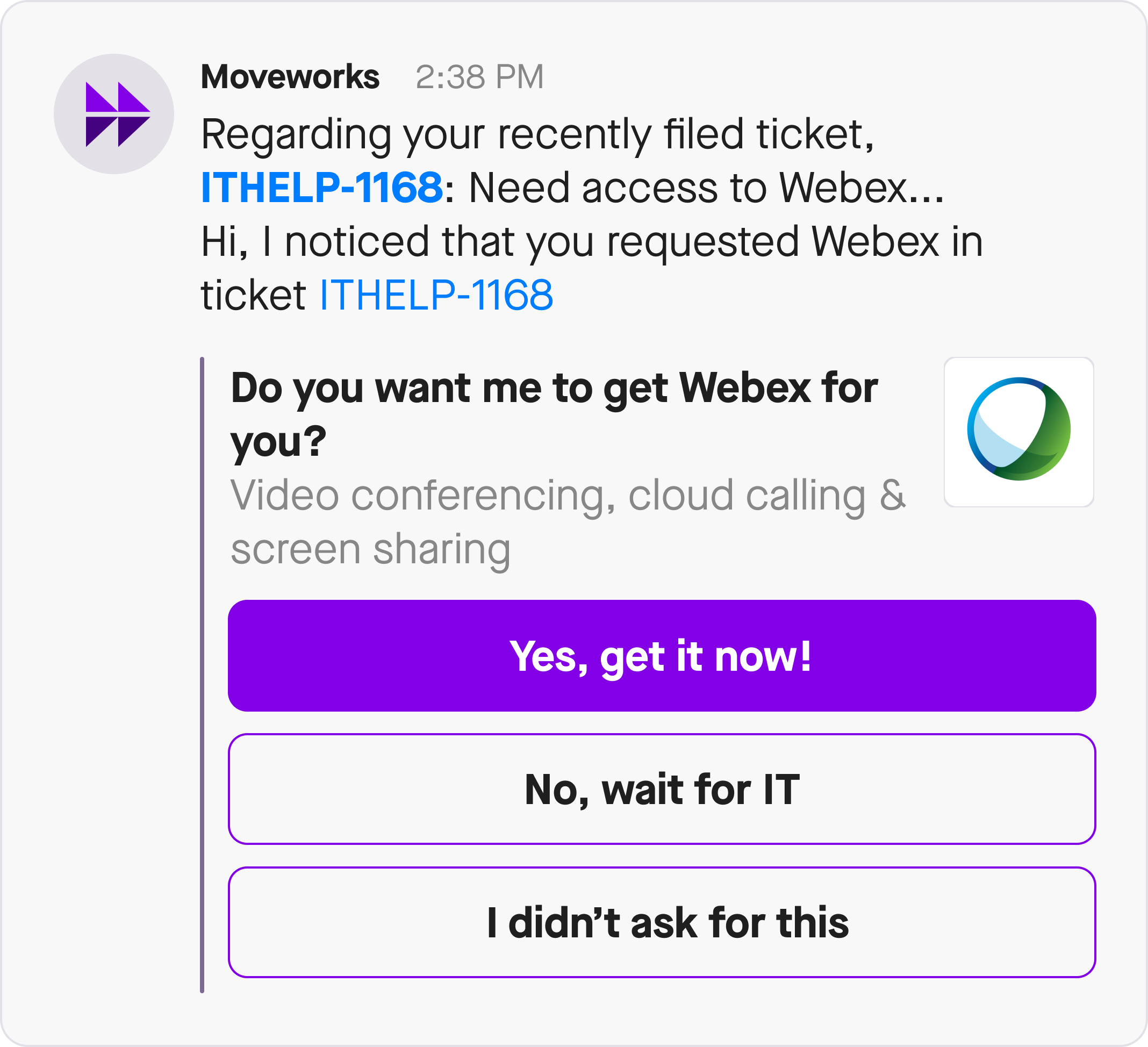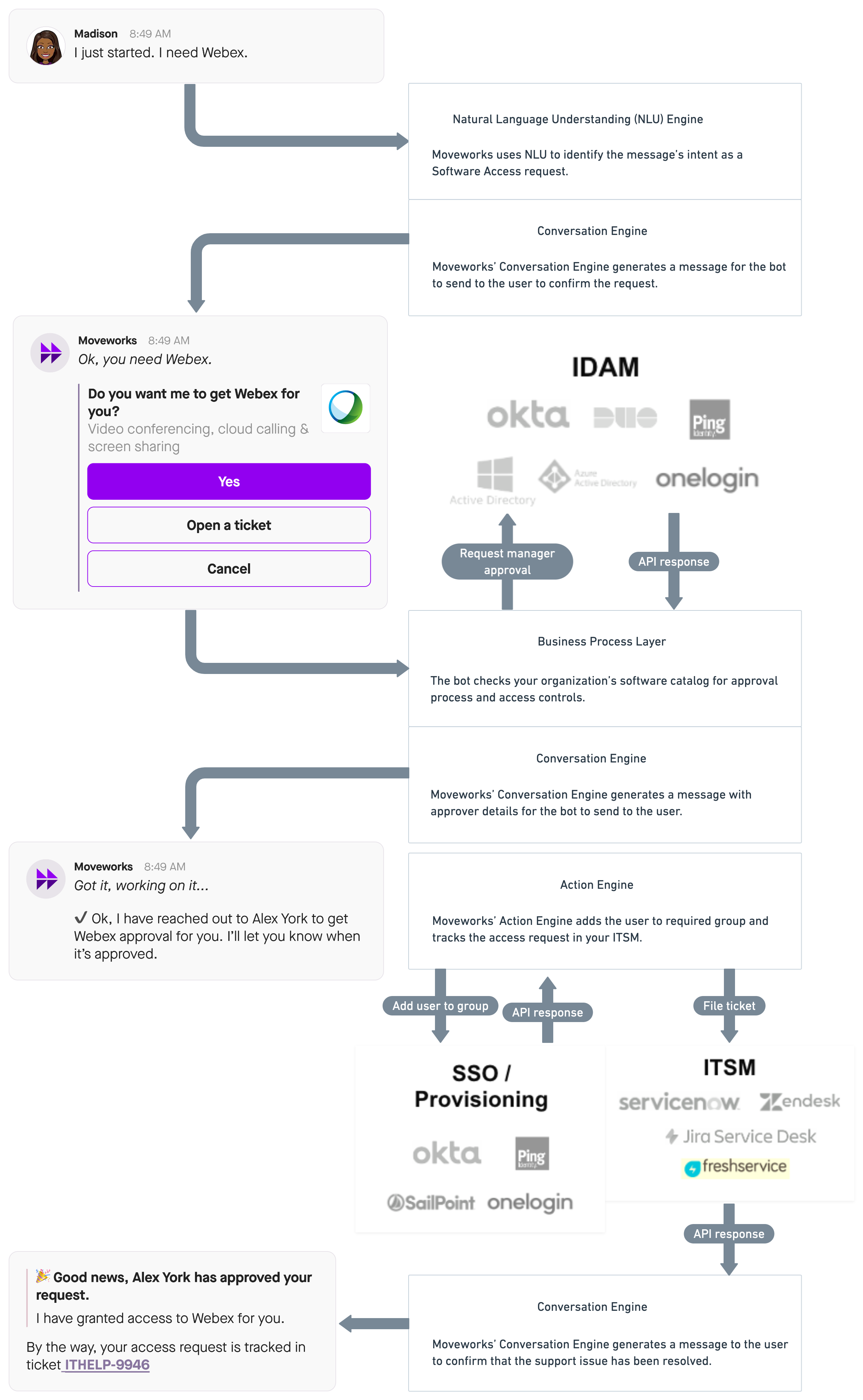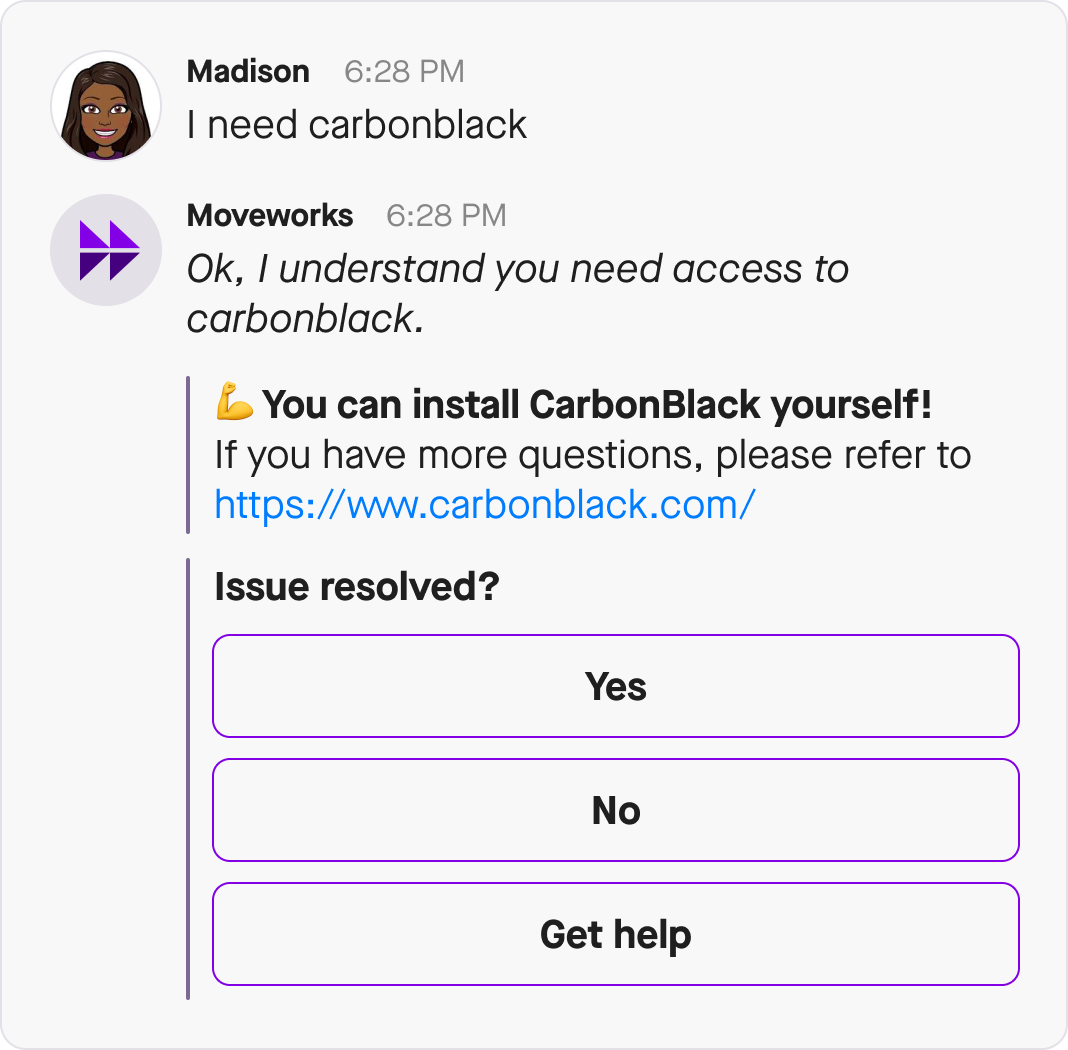Software Access [DEPRECATED]
This covers only Moveworks ClassicFor Moveworks Copilot experiences, refer to "Moveworks Copilot - Feature Overview" page.
Overview
Moveworks Software Access enables users to self-service the provisioning of software applications. Users can tell the Moveworks bot what software or service they need, and the bot will secure the necessary approvals to grant access to the request software, which is done by integrating with your organization’s identity and access management (IDAM) systems. The bot can also provision software for a user if they requested access through other channels such as forms, tickets, or email. If the software is not enabled for auto-provisioning the bot can accelerate the provisioning process by gathering the information needed, or giving users self-service instructions for the installation process.
Software Access can:
- Secure the necessary approvals and instructs your application provisioning tool to grant the user access to the application.
- Accelerate approvals through chat when approvals are needed.
- Help users choose the right applications when multiple kinds of license types are available
- Direct the user to a how-to guide for applications that require installation by the user.
- Tell the user if the IT department does not support the application, and suggest alternatives.
- Intercept software request tickets from email and self-service portal to proactively resolves the ticket by reaching out to the user to assist with provisioning the application.
Access Software Routes
Access software by chatting with the bot
To request new software applications through the Moveworks bot, you can message the bot to request the software or services you need. Some common requests are:
- “I need MS Office”
- “How do I get a WebEx account?”
- “Can I get access to Trello?”
- ”I am about to join a sales call but don't have zoom, can you help?”
- “I need docusign for an incoming purchase order”
Once you tell the bot what application or software you need, the bot will understand you are making a software access request, and the application or service you are asking for. It will then ask you if you want to provision this software. In the bot’s reply, you can click on Yes, if the bot replies offering you the correct application you requested. If the bot offers to provision you the incorrect application, you can click on Not relevant.

When you confirm your request with the bot by clicking on Yes, it will then take action based on the configuration of the application within Moveworks. The sections below cover the different ways software can be handled within the Moveworks bot.
Access software by filing a traditional ticket

Moveworks can help users who aren’t even aware of the bot yet, users who are requesting access to software applications through traditional channels such as email or the self-service portal. Moveworks polls your ticketing system for tickets requesting software. And when it finds a ticket asking for software access, the bot contacts the user to offer assistance provisioning the requested software. If the software that the bot is offering to provision for the user is the correct one, they can click on Yes, get it now! and follow the process configured for this specific application.
Access software by requesting in a Slack channel
How does Software Access work?
The steps below walk through an example of a software request with approvals collection and provisioning to IDAM groups.

1. Understanding the request
Moveworks uses Natural Language Understanding (NLU) to understand software application requests from users. During Implementation, Moveworks also performs entity mining to capture custom software entities from your ticketing data, and other sources, to better recognize what software users may request.
If you have a structured set of software names and standards or custom names for brand standard applications, please inform your Customer Success team. For example, some organizations may refer to ServiceNow as “1Support”. These entities will be added into the Moveworks Enterprise Graph.
2. Access Control
After a user requests access for a software application, the bot checks whether or not the user’s role and attributes allow them to access the requested software.
3. Information Intake
Once the bot has confirmed the user can access the software they’re asking for, it will gather the relevant information necessary to fulfill the user’s request such as business justifications. For more complex software requests, admins can create Forms in their organization’s ticketing system to gather information.
4. Business Process Workflow
Moveworks leverages your existing process workflows to handle complex business processes, with the most common business process being Approvals. Supported approval workflows include, but are not limited to:
- Manager Approval
- Application Owner Approval
- Auto-Approval / Entitlement for certain users
- Parallel Approval
- One-of Approvals
- Approval Groups
Admins may want to create subtasks that route to other teams, this can be done by leveraging your organization’s Ticketing Workflow Engine (Jira Service Desk, ServiceNow, or Fresh Service).
Moveworks can work with your organizations to build chat-native approval workflows through the Moveworks Approval Engine.
5. Software Provisioning
Moveworks integrates with your IDAM tools to start provisioning workflows by adding users to IDAM groups (Okta, AD, Azure AD, GSuite, OneLogin, etc.).
To manage provisioning actions through Moveworks, admins can select SCIM-enabled app integrations in your IDAM system (Okta, OneLogin, Azure AD).
Configuration options
Group-based Provisioning
As seen above, Moveworks can integrate with your IDAM system(s) and add users to groups to trigger account creation/ provisioning processes. Supported systems include:
- Azure AD Security Groups
- AD Security Groups
- LDAP Groups
- Okta
- OneLogin
- Google Workplace
Form finding & filling
By leveraging Forms in your organization’s ITSM system, you can provide a structured way to gather information required to fulfill a software request and/or start custom provisioning workflows.
Self-service instructions

Moveworks can be configured to provide the end user a set of instructions. The instructions guide users through the installation process, or guide them to an alternative application if the application they are requesting is not supported.
Deep Links
Deep links send users straight to specific in-app location where they can start the automated installation process. For software requests that require installation of a program onto an end user’s computer, Moveworks supports deep links to SCCM and JAMF.
In some cases, the option to install the software may not be available until the user is added to a group in your IDAM system.
Unsupported application flow
When a user requests access to software that is not supported by your organization, the bot can be configured to recognize these kind of software requests and give the user alternative options for software that is supported and/or provide links to KB articles on how users can access the supported software.
Updated 2 months ago